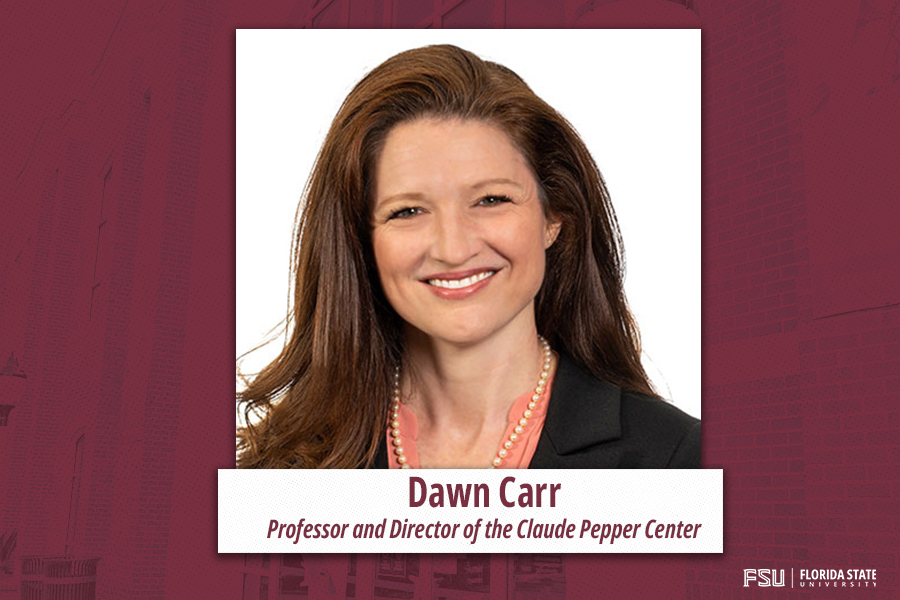
National Senior Citizens Day is on Aug. 21, highlighting awareness of the physical and mental challenges experienced by older adults.
The Centers for Disease Control and Prevention (CDC) announced in April that 93% of adults age 65 and older have at least one chronic condition, while 79% have two or more. Senior citizens make up 18% of the current United States population with 62 million people, a number projected to grow to over 88 million by 2050.
Florida State University’s Dawn Carr is a sociology professor and Director of the Claude Pepper Center. Her research identifies and leverages factors that bolster older adults’ ability to remain healthy and active for as long as possible. Carr’s work over the past decade has focused on understanding the complex pathways between health and active engagement during the second half of life.
The Claude Pepper Center aims to identify policy solutions that enhance the financial, psychological, cognitive, physical and social well-being of older adults and their families in the state of Florida and beyond.
Carr has expertise on the stressors and life transitions that affect the elderly population’s health. Some examples include retirement, later life employment, social networks and social relationships, major health events, and critical health setbacks.
Her recent research includes the role of early life experiences and exposures over the course of life, and the ways in which individual psychological resources facilitate resilient outcomes in later life.
Media interested in interviewing Carr about the challenges faced by senior citizens may contact her at dccarr@fsu.edu.
Dawn Carr, Professor and Director of the Claude Pepper Center, College of Social Sciences and Public Policy
How do social connections and community involvement impact the well-being of older adults?
Relative to almost all other lifestyle related behaviors and pharmaceutical interventions, social engagement is among the most important in shaping health outcomes in later life. There are a variety of reasons why we believe that social isolation and loneliness are particularly detrimental to health, especially over long periods of time, but we believe that social engagement and community involvement leads to more physical activity, more cognitive activity, and a stronger sense of meaning, purpose, and connection, and isolation and loneliness does the opposite – leads to more sedentary behavior, less cognitive engagement, and poor mental health. This improves responses to stressors and motivates people to take care of their health and well-being so they can show up for the things that matter in their lives. Perhaps just as important, when we feel like we don’t belong or we aren’t useful to the world, we tend to experience significant mental health problems which accelerates aging processes and contributes to onset of a variety of new health problems, including accelerated mortality. Humans are social beings, and older adults thrive when they are embedded in social environments where they feel connected to others in meaningful ways.
How can families best support aging loved ones while respecting their independence and dignity?
There are a variety of ways that families can support their aging loved ones, but every older adult has different needs. What’s important is to connect with the older adults in your family and meet them where they are. Our goals change as we age, and beyond ensuring that our family members are safe, it’s important to identify what they need to feel like they can thrive and have a good quality of life. Sometimes older adults do not want to leave their homes, but their goals in life are not attainable in the environments in which they are living. Helping family members get their needs met may mean helping them learn about their options for how they can be embedded in the environments that allow them to be as independent as possible and also meet their life goals, and this may include different living situations.
What are the most common physical and mental health challenges faced by seniors today, and how can they be effectively managed?
The most common challenges relate to physical disability and cognitive impairment that make them unable to perform everyday activities that they need to live without the help of others. There are a few different ways to manage these issues. One is to identify options for supplemental help from family or a paid caregiver that comes to the home to cover activities that are a struggle. If that doesn’t work, institutional care may be needed. Another important way to help manage these issues is to engage in physical activities that help improve physical function or prevent decline from occurring in the future. This may require help from a professional for people who have not previously engaged in regular physical activity. Targeted exercise programs can significantly improve mobility.
In terms of cognitive impairment, it is more difficult to address problems once they have occurred. However, we always start by making sure any cognitive problems are not explained by issues that can be addressed in other ways – certain medications, other health problems that are not being addressed and manifesting with cognitive issues (e.g., depression or anxiety). If those issues are addressed and cognitive problems persist, then it may be useful to obtain professional help with assessing and monitoring cognitive changes over time to see if the condition is worsening, and identifying appropriate interventions to slow the decline as much as possible. For many people, however, cognitive losses require support from a caregiver to help ensure that people are able to be safe in navigating everyday activities.
What are some of the latest advances in aging research or technology that show promise for improving quality of life for seniors?
I am not someone who knows a lot about specific advances in consumer products at the moment, but some of the most important are addressing hearing loss, which is a significant factor in shaping cognitive health. It is easier than ever to obtain hearing corrective devices, and the earlier people address hearing loss, the better they can avoid long-term cognitive consequences.
In addition, there is a growing number of devices that allow people to monitor their health behaviors and health metrics so they know what kinds of activities they are engaging in and how that may be changing various health metrics (e.g., walking every day may lead to healthier blood pressure levels which can be monitored regularly). Another important technological advancement that shouldn’t be ignored are the variety of products that are being developed for use in home environments that help signal to older people before they experience a health crisis when they may want to engage with a health care provider. Many devices are Bluetooth capable and can be uploaded to devices that collect combined health metrics that can be used to assess well-being and identify patterns that suggest a need for intervention.
What policies or programs do you believe are most important to improve senior care and address the needs of an aging population?
I strongly believe that home and community programs, particularly those associated with the Older American’s Act, are among the most important programs for ensuring that older people can remain active, socially integrated in the community, and have access to basic resources and food. These programs also rely on a strong base of volunteers, many of whom are older people themselves, and volunteering is an especially meaningful and health-promoting activity. The most effective way to ensure that future older adults can remain healthy as long as possible, however, is to expand the scope of aging research and policies to include those who are of younger ages. By the time people reach later life, there is less that can be done to help people improve their health and well-being in a significant way. But, if we have programs that ensure access to good quality medical care during mid-life and make it possible to address problems in their earliest stages, we are more likely to have the ability to remain active and productive into very late life. This is key for quality of life, but it’s also a critical way for us to manage our growing health care burden looking ahead.




